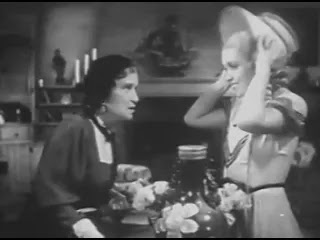This is my fourth encounter with a Frank Strayer film, following The Monster Walks, The Vampire Bat, and The Ghost Walks, and he hasn't won me over yet. The Vampire Bat benefited from a great cast, a weird script, and leftover sets from Frankenstein, but, for the most part, Strayer is an extremely clunky and pedestrian visual stylist (though he usually had to work within serious financial constraints). The 1930s were a golden age for horror, but I wouldn't include Strayer anywhere near the pantheon of legends. To put it in 1980s pro wrestling terms, Strayer is the Bill and Randy Mulkey of '30s horror, and The Vampire Bat was his Mulkeys vs. Gladiators match.
Condemned to Live does have an unusual story with some potential, however unrealized. It's a vampire tale with the vampire not even aware he's a bloodsucker until it's too late. Professor Paul Kristan (Ralph Morgan) is the town doctor, advice-giver, and benevolent figurehead. The other villagers go on and on about what a swell guy Paul is and also how he works too hard. These two points are addressed roughly every three minutes. He's engaged to marry kindly and sweet Marguerite (Maxine Doyle), irritating her previous sweetheart David (Russell Gleason), who is still in love with Marguerite but knows that his broke ass will never get permission to marry her from her old man John (Carl Stockdale). Our other important characters are Paul's foster father and colleague, Dr. Anders Bizet (Pedro de Cordoba), his hunchbacked and devoted assistant Zan (Mischa Auer), and his fiercely protective housekeeper Mother Molly (Lucy Beaumont).
Things would be relatively hunky dory, except villagers are being murdered and drained of blood, and Paul is experiencing brutal headaches and loss of memory. Could these events be connected? Duh. Unfortunately for Paul, and unbeknownst to him, he's a damn vampire. His vampirism origin story is convoluted and racist, and only Anders knows about it. Paul's parents were explorers, and they and a colleague were on an expedition in "deepest, darkest Africa" while his mother was pregnant. Incurring the wrath of the natives, they hid in a cave infested with large vampire bats, one of which bit Paul's mother shortly before she gave birth. She died, and shortly afterwards Paul's father and his colleague died as well. Family friend Anders adopted the young Paul, and kept a close eye on him to see if he would become a vampire. Paul showed no signs of vampirism until the present day, when stress and overwork caused his dormant vampire to bloom. I'm all for suspension of disbelief within a film, but that's a pretty weak (and deeply strange) excuse.
Condemned to Live takes the unusual and fiscally responsible tack of completely foregoing special effects, except for the giant rubber bat in the opening scene. There are no vampire teeth, no transformations, no blood, no makeup effects besides the normal stage makeup for the actors. Morgan just scrunches his face up into a tortured expression whenever he has to deliver Paul's vampire self, and the bodies are placed with their faces away from the camera so we never see the bite marks or the effects of blood drainage. A visually skilled filmmaker could do fascinating things with performance and camera movement in place of special effects, but in the hands of Strayer, it just adds to the movie's lack of punch.
Condemned to Live is full of boringly static shots, stiff performances, and a real lack of suspense, excitement, and terror. I like the angle of a tragic villain who has no idea he's the one killing the villagers, but it's just not that excitingly delivered. In the film's defense, it is only 67 minutes long. Proceed with caution.


















